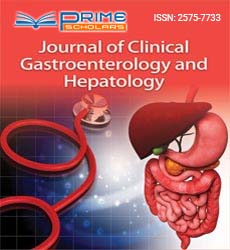Perspective - (2023) Volume 7, Issue 4
Colon Polyps Types, Risks, and Potential for Cancer Development
Qiyuan Yang*
Department of Molecular, Cell and Cancer Biology, University of Massachusetts Medical School, USA
*Correspondence:
Qiyuan Yang,
Department of Molecular, Cell and Cancer Biology, University of Massachusetts Medical School,
USA,
Email:
Received: 01-Aug-2023, Manuscript No. IPJCGH-23-17329;
Editor assigned: 03-Aug-2023, Pre QC No. IPJCGH-23-17329 (PQ);
Reviewed: 17-Aug-2023, QC No. IPJCGH-23-17329;
Revised: 22-Aug-2023, Manuscript No. IPJCGH-23-17329 (R);
Published:
29-Aug-2023, DOI: 10.36648/2575-7733.7.4.34
Introduction
Colon cancer and rectal cancer are frequently grouped together
due to their numerous similarities. Most of the inner organ
is included the colon, a solid chamber around 5 feet long. The
name of each part of the colon is determined by the direction
in which the food is moving through it. The name of the first
section is an ascending colon. It starts in a pocket known as
the cecum, where food that has not been processed enters
the body from the small digestive tract. On the right half of
the mid-region it continues vertically. The second section is referred
to as the transverse colon. It connects the body’s right
and left sides.
Description
The third region is known as the plunging colon since it slides
goes down on the left side. The fourth region is known as the
sigmoid colon considering its “S” shape. The rear-end is associated
with the rectum by the sigmoid colon going along with it to
the last option. Although some kinds of polyps can develop into
malignant growths over time usually many years, not all polyps
become disease. The type of polyp determines the likelihood
that it will develop into a disease. Polyps arrive in different
structures. Adenomas and adenomatous polyps: These polyps
every so often form into disease. Adenomas are therefore categorized
as a pre-harmful condition. The 3 sorts of adenomas
are adjusted, villous, and tubulovillous. Hyperplastic polyps
and provocative polyps: Despite the fact that they are ordinarily
not pre-dangerous, these polyps are more common. A few
people are bigger than 1 cm. Hyperplastic polyps could require
colorectal sickness screening with colonoscopy on a more normal
premise. Customary serrated adenomas (TSA) and sessile
serrated polyps (SSP): Since they are bound to foster colorectal
disease, these polyps are oftentimes treated in much the same
way to adenomas. The development of cells known as colon
disease begins in the colon, a part of the digestive system. The
first and longest piece of the digestive organ is the colon. The
large intestine is the final component of the digestive system.
The stomach related system isolates sustenance for the body
to use. Malignant growth of the colon typically affects older
adults, but it can happen at any age. More often than not, it
begins in that frame of mind as little bunches of cells called
polyps. Despite the fact that most polyps aren’t cancerous,
some can turn into colon cancer in time. Polyps regularly don’t
cause secondary effects. Consequently, specialists recommend
routine colon polyp screening tests. Colon malignant growth
can be tried not to by find and eliminating polyps. In the event
that colon cancer develops, numerous medications can assist
in controlling it. Treatment options include medical procedures
like chemotherapy, targeted therapy, and immunotherapy, as
well as radiation therapy. Colon sickness makes from polyps
improvements in your colon’s inner covering. Precancerous
polyps can be recognized and eliminated through screening
methodology and therapies presented by medical care suppliers.
If untreated, colon threatening development could spread
to various district of your body. Less people are dying from colon
cancer as a result of these tests, early treatment, and new
treatments.
Conclusion
Certain polyps, or developments, in your colon’s internal covering
can prompt malignant growth. Precancerous polyps can
be identified by medical services suppliers utilizing screening
tests before they can form into destructive growths. On the off
chance that you don’t catch or treat colon malignant growth, it
could spread to different pieces of your body.
Citation: Yang Q (2023) Colon Polyps Types, Risks, and Potential for Cancer Development. J Clin Gastroenterol Hepatol. 7:34.
Copyright: © 2023 Yang Q. This is an open-access article distributed under the terms of the Creative Commons Attribution License,
which permits unrestricted use, distribution, and reproduction in any medium, provided the original author and source
are credited.

